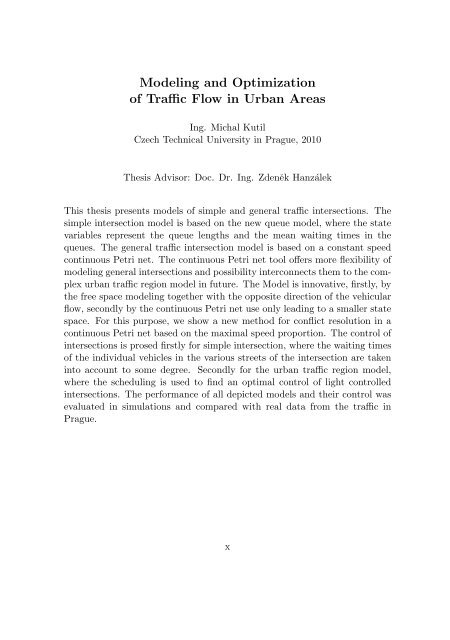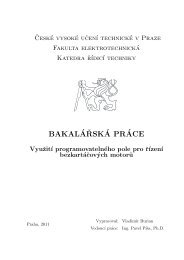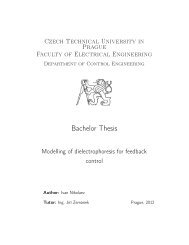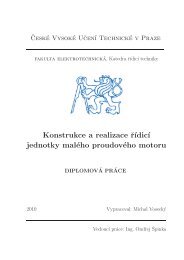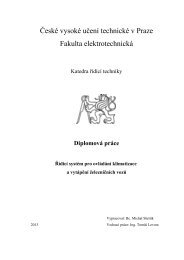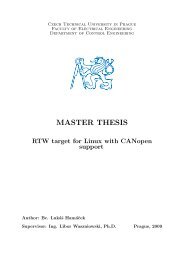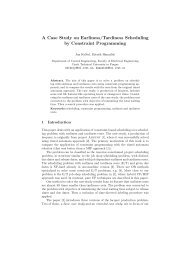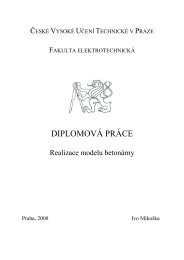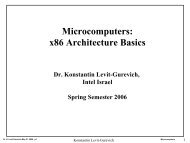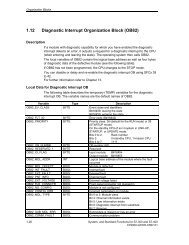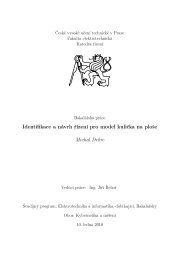Modeling and Optimization of Traffic Flow in Urban Areas - Czech ...
Modeling and Optimization of Traffic Flow in Urban Areas - Czech ...
Modeling and Optimization of Traffic Flow in Urban Areas - Czech ...
Create successful ePaper yourself
Turn your PDF publications into a flip-book with our unique Google optimized e-Paper software.
<strong>Model<strong>in</strong>g</strong> <strong>and</strong> <strong>Optimization</strong><strong>of</strong> <strong>Traffic</strong> <strong>Flow</strong> <strong>in</strong> <strong>Urban</strong> <strong>Areas</strong>Ing. Michal Kutil<strong>Czech</strong> Technical University <strong>in</strong> Prague, 2010Thesis Advisor: Doc. Dr. Ing. Zdeněk HanzálekThis thesis presents models <strong>of</strong> simple <strong>and</strong> general traffic <strong>in</strong>tersections. Thesimple <strong>in</strong>tersection model is based on the new queue model, where the statevariables represent the queue lengths <strong>and</strong> the mean wait<strong>in</strong>g times <strong>in</strong> thequeues. The general traffic <strong>in</strong>tersection model is based on a constant speedcont<strong>in</strong>uous Petri net. The cont<strong>in</strong>uous Petri net tool <strong>of</strong>fers more flexibility <strong>of</strong>model<strong>in</strong>g general <strong>in</strong>tersections <strong>and</strong> possibility <strong>in</strong>terconnects them to the complexurban traffic region model <strong>in</strong> future. The Model is <strong>in</strong>novative, firstly, bythe free space model<strong>in</strong>g together with the opposite direction <strong>of</strong> the vehicularflow, secondly by the cont<strong>in</strong>uous Petri net use only lead<strong>in</strong>g to a smaller statespace. For this purpose, we show a new method for conflict resolution <strong>in</strong> acont<strong>in</strong>uous Petri net based on the maximal speed proportion. The control <strong>of</strong><strong>in</strong>tersections is prosed firstly for simple <strong>in</strong>tersection, where the wait<strong>in</strong>g times<strong>of</strong> the <strong>in</strong>dividual vehicles <strong>in</strong> the various streets <strong>of</strong> the <strong>in</strong>tersection are taken<strong>in</strong>to account to some degree. Secondly for the urban traffic region model,where the schedul<strong>in</strong>g is used to f<strong>in</strong>d an optimal control <strong>of</strong> light controlled<strong>in</strong>tersections. The performance <strong>of</strong> all depicted models <strong>and</strong> their control wasevaluated <strong>in</strong> simulations <strong>and</strong> compared with real data from the traffic <strong>in</strong>Prague.x


